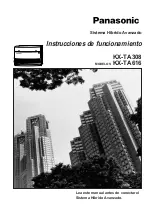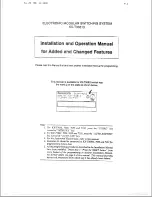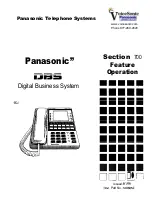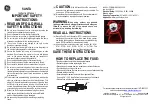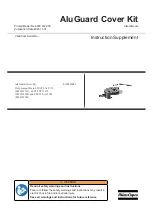
23
Base Unit Operation
COOLING, UNITS WITHOUT ECONOMI$ER — When
thermostat calls for cooling, terminals G and Y1 are energized.
The indoor (evaporator) fan contactor (IFC), and compressor
contactor no. 1 (C1) are energized and evaporator-fan motor,
compressor no. 1 and condenser fans start. The condenser-fan
motors run continuously while unit is cooling. If the thermostat
calls for a second stage of cooling by energizing Y2, compres-
sor contactor no. 2 (C2) is energized and compressor no. 2
starts.
HEATING, UNITS WITHOUT ECONOMI$ER (If Acces-
sory or Optional Heater is Installed) — Upon a call for heat-
ing through terminal W1, IFC and heater contactor no. 1 (HC1)
are energized. On units equipped for 2 stages of heat, when ad-
ditional heat is needed, HC2 is energized through W2.
COOLING UNITS WITH ECONOMI$ER — When the
OAT is above the ECON SP set point and the room thermostat
calls for Stage 1 cooling (R to G + Y1), the indoor-fan motors
(IFM) is energized and the EconoMi$er damper modulates to
minimum position. The compressor contactor and OFC are
energized to start the compressor and outdoor-fan motor
(OFM). After the thermostat is satisfied, the damper modulates
to the fully closed position when the IFM is deenergized.
When the OAT is below the ECON SP setting and the room
thermostat calls for Stage 1 cooling (R to G + Y1), the
EconoMi$er modulates to the minimum position when the
IFM is energized. The EconoMi$er provides Stage 1 of cooling
by modulating the return and outdoor air dampers to maintain a
55 F supply air set point. If the supply-air temperature (SAT) is
greater than 57 F, the EconoMi$er modulates open, allowing a
greater amount of outdoor air to enter the unit. If the SAT drops
below 53 F, the outdoor air damper modulates closed to reduce
the amount of outdoor air. When the SAT is between 53 and
57 F, the EconoMi$er maintains its position.
If outdoor air alone cannot satisfy the cooling requirements
of the conditioned space, and the OAT is above the MECH
CLG LOCKOUT set point, the EconoMi$er integrates free
cooling with mechanical cooling. This is accomplished by the
strategies below.
NOTE: Compressors have a two-minute Minimum On and
Minimum Off, which are accomplished by the strategies
below.
1. If Y1 is energized, and the room thermostat calls for Y2
(2-stage thermostat), the compressor and OFC are ener-
gized. The position of the EconoMi$er damper is main-
tained at its current value.
2. If Y1 is energized for more than 20 minutes, and Y2 is
not energized (whether or not a 2-stage thermostat is
used), the compressor and OFC are energized. The posi-
tion of the EconoMi$er damper is maintained at its cur-
rent value.
3. If Y1 is energized, and compressor no. 1 is already ener-
gized (see Step 2) and the room thermostat calls for Y2,
compressor no. 1 continues to operate. If Y2 remains
energized for more than 20 minutes, compressor no. 2 is
energized.
NOTE: Compressor no. 2 cannot be energized unless there is a
signal for Y2 from the space thermostat.
4. If compressor no. 2 is energized, and the Y2 signal from
the thermostat is satisfied, compressors 1 and 2 are deen-
ergized. Re-asserting Y2 will start compressor no. 1 and
(after a 20-minute interstage delay) compressor no. 2.
5. If compressor no. 1 is energized and the thermostat is sat-
isfied, compressor no. 1, the OFM, and IFM are deener-
gized and the EconoMi$er modulates closed.
When the OAT is below the MECH CLG LOCKOUT set
point, the compressors remain off.
FREEZE PROTECTION THERMOSTAT(S) — A freeze
protection thermostat (FPT) is located on the top and bottom of
the evaporator coil. It detects frost build-up and turns off the
compressor, allowing the coil to clear. Once frost has melted,
the compressor can be reenergized by resetting the compressor
lockout.
HEATING, UNITS WITH ECONOMI$ER (If Accessory or
Optional Heater is Installed) — When the room thermostat
calls for heat, the heating controls are energized as described in
the Heating, Units Without EconoMi$er section. The IFM is
energized and the EconoMi$er damper modulates to the mini-
mum position. When the thermostat is satisfied, the damper
modulates closed.
UNITS WITH MOISTUREMISER DEHUMIDIFICATION
PACKAGE — When thermostat calls for cooling, terminals G
and Y1 and/or Y2 and the compressor contactor C1 and/or C2
are energized. The indoor (evaporator) fan motor (IFM), com-
pressors, and outdoor (condenser) fan motors (OFM) start. The
OFMs run continuously while the unit is in cooling. As shipped
from the factory, both MoistureMiser dehumidification circuits
are always energized.
If MoistureMiser circuit modulation is desired, a field-
installed, wall-mounted humidistat is required. If the Mois-
tureMiser humidistat is installed and calls for the Mois-
tureMiser subcooler coil to operate, the humidistat internal
switch closes. This energizes the 3-way liquid line solenoid
valve coils (LLSV1 for circuit 1 and LLSV2 for circuit 2) of
the MoistureMiser circuits, forcing the warm liquid refrigerant
of the liquid line to enter the subcooler coils. See Fig. 30.
As the warm liquid passes through the subcooler coils, it is
exposed to the cold supply airflow coming off the evaporator
coils and the liquid is further cooled to a temperature approach-
ing the evaporator coil leaving-air temperature. The state of the
refrigerant leaving the subcooler coils is a highly subcooled liq-
uid refrigerant. The liquid then enters a thermostatic expansion
valve (TXV) where the liquid is dropped to the evaporator
pressure. The TXVs can throttle the pressure drop of the liquid
refrigerant and maintain proper conditions at the compressor
suction valves over a wide range of operating conditions. The
liquid proceeds to the evaporator coils at a temperature lower
than normal cooling operation. This lower temperature is what
increases the latent and sensible capacity of the evaporator
coils.
The 2-phase refrigerant passes through the evaporators and
is changed into a vapor. The air passing over the evaporator
coils will become colder than during normal operation as a re-
sult of the colder refrigerant temperatures. However, as it pass-
es over the subcooler coils, the air will be warmed, decreasing
the sensible capacity and reducing the sensible heat of the roof-
top unit.
As the refrigerant leaves the evaporator, the refrigerant
passes a subcooler control low-pressure switch (S-LPS1 for
circuit 1 or S-LPS2 for circuit 2) in the suction line. This low-
pressure switch will deactivate the MoistureMiser package
when the suction pressure reaches 60 psig. The subcooler con-
trol low-pressure switch is an added safety device to protect
against evaporator coil freeze-up during low ambient opera-
tion. The subcooler control low-pressure switch will only
deactivate the 3-way liquid line solenoid valve in the Mois-
tureMiser circuit. The compressors will continue to run as long
as there is a call for cooling, regardless of the position of the
subcooler control low-pressure switch. The 3-way solenoid
valve and the MoistureMiser package will be reactivated only
when the call for cooling has been satisfied, the subcooler con-
trol low-pressure switch has closed above 80 psig, and a new
call for cooling exists. The crankcase heaters on the scroll com-
pressors provide additional protection for the compressors due
to the additional refrigerant charge in the subcooler.
Содержание 50TJ016
Страница 35: ......





























